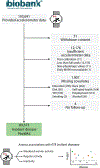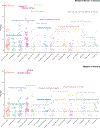Associations of "Weekend Warrior" Physical Activity With Incident Disease and Cardiometabolic Health
- PMID: 39324186
- PMCID: PMC11803568
- DOI: 10.1161/CIRCULATIONAHA.124.068669
Associations of "Weekend Warrior" Physical Activity With Incident Disease and Cardiometabolic Health
Abstract
Background: Achievement of guideline-recommended levels of physical activity (≥150 minutes of moderate-to-vigorous physical activity per week) is associated with lower risk of adverse cardiovascular events and represents an important public health priority. Although physical activity commonly follows a "weekend warrior" pattern, in which most moderate-to-vigorous physical activity is concentrated in 1 or 2 days rather than spread more evenly across the week (regular), the effects of physical activity pattern across a range of incident diseases, including cardiometabolic conditions, are unknown.
Methods: We tested associations between physical activity pattern and incidence of 678 conditions in 89 573 participants (62±8 years of age; 56% women) of the UK Biobank prospective cohort study who wore an accelerometer for 1 week between June 2013 and December 2015. Models were adjusted for multiple baseline clinical factors, and P value thresholds were corrected for multiplicity.
Results: When compared to inactive (<150 minutes moderate-to-vigorous physical activity/week), both weekend warrior (267 total associations; 264 [99%] with lower disease risk; hazard ratio [HR] range, 0.35-0.89) and regular activity (209 associations; 205 [98%] with lower disease risk; HR range, 0.41-0.88) were broadly associated with lower risk of incident disease. The strongest associations were observed for cardiometabolic conditions such as incident hypertension (weekend warrior: HR, 0.77 [95% CI, 0.73-0.80]; P=1.2×10-27; regular: HR, 0.72 [95% CI, 0.68-0.77]; P=4.5×10-28), diabetes (weekend warrior: HR, 0.57 [95% CI, 0.51-0.62]; P=3.9×10-32; regular: HR, 0.54 [95% CI, 0.48-0.60]; P=8.7×10-26), obesity (weekend warrior: HR, 0.55 [95% CI, 0.50-0.60]; P=2.4×10-43, regular: HR, 0.44 [95% CI, 0.40-0.50]; P=9.6×10-47), and sleep apnea (weekend warrior: HR, 0.57 [95% CI, 0.48-0.69]; P=1.6×10-9; regular: HR, 0.49 [95% CI, 0.39-0.62]; P=7.4×10-10). When weekend warrior and regular activity were compared directly, there were no conditions for which effects differed significantly. Observations were similar when activity was thresholded at the sample median (≥230.4 minutes of moderate-to-vigorous physical activity/week).
Conclusions: Achievement of measured physical activity volumes consistent with guideline recommendations is associated with lower risk for >200 diseases, with prominent effects on cardiometabolic conditions. Associations appear similar whether physical activity follows a weekend warrior pattern or is spread more evenly throughout the week.
Keywords: accelerometry; cardiovascular disease; physical activity; prevention; weekend warrior.
Conflict of interest statement
P.T.E. receives sponsored research support from Bayer AG, Bristol Myers Squibb, Pfizer, and Novo Nordisk; he has also served on advisory boards or consulted for Bayer AG. S.A.L. is an employee of Novartis as of July 2022. S.A.L. received sponsored research support from Bristol Myers Squibb, Pfizer, Boehringer Ingelheim, Fitbit, Medtronic, Premier, and IBM, and has consulted for Bristol Myers Squibb, Pfizer, Blackstone Life Sciences, and Invitae. The other authors report no conflicts.
Figures




References
-
- Arnett DK, Blumenthal RS, Albert MA, Buroker AB, Goldberger ZD, Hahn EJ, Himmelfarb CD, Khera A, Lloyd-Jones D, McEvoy JW, Michos ED, Miedema MD, Muñoz D, Smith SC Jr, Virani SS, Williams KA Sr, Yeboah J, Ziaeian B. 2019 ACC/AHA guideline on the primary prevention of cardiovascular disease: A report of the American college of cardiology/American heart association task force on clinical practice guidelines. Circulation. 2019;140:e563–e595. - PMC - PubMed
-
- Stens NA, Bakker EA, Mañas A, Buffart LM, Ortega FB, Lee D-C, Thompson PD, Thijssen DHJ, Eijsvogels TMH. Relationship of daily step counts to all-cause mortality and cardiovascular events. J Am Coll Cardiol. 2023;82:1483–1494. - PubMed
-
- World Health Organization. Global Recommendations on Physical Activity for Health. Geneva: World Health Organization; 2010. - PubMed
-
- National Health Service. Physical activity guidelines for adults aged 19 to 64. Accessed May 31, 2023. https://www.nhs.uk/live-well/exercise/exercise-guidelines/physical-activ....
MeSH terms
Grants and funding
LinkOut - more resources
Full Text Sources
Medical

